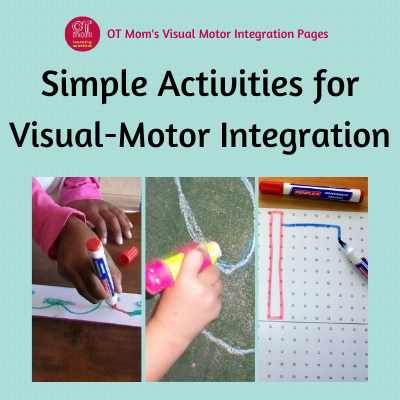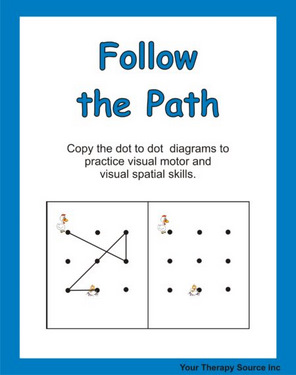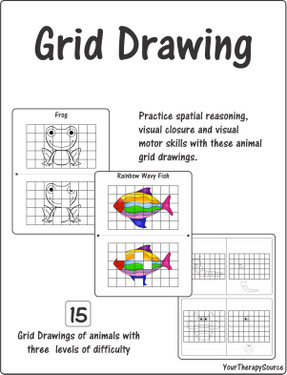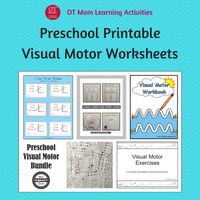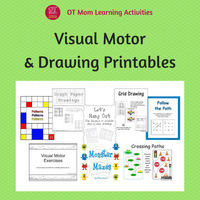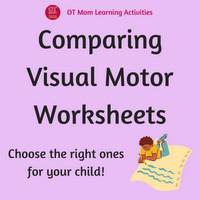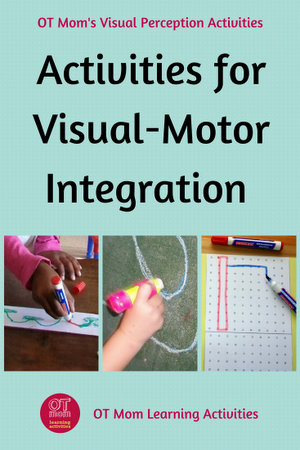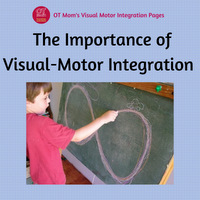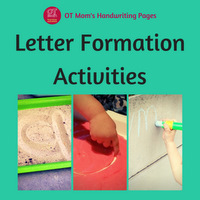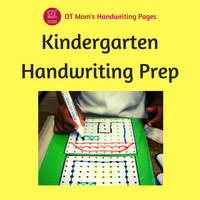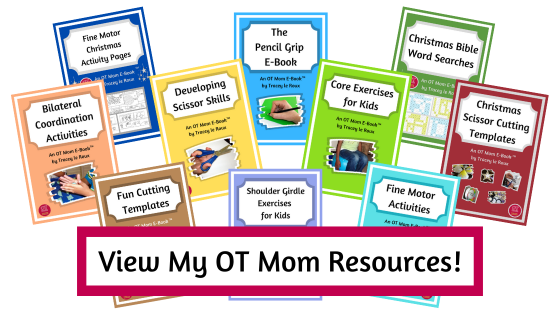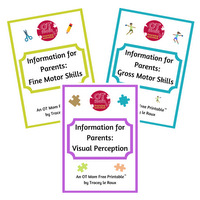- Home Page
- Visual Motor Integration
- Visual Motor Integration Activities
Visual Motor Integration Activities
The visual motor integration activities on this page will help your child to learn to perceive and copy shapes, numbers and letters correctly to help with handwriting skills. There are some ideas on this page to help older kids as well!
What Is Visual-Motor Integration Anyway?
Visual-Motor Integration (also known as VMI) is the effective, efficient communication between the visual systems and the motor systems.
This can help your child correctly copy or draw the shapes, numbers and letters that he/she sees, which is important for handwriting.
There are a number of VMI activities that children can do, to develop these important skills, starting with tracing and copying simple shapes and diagonal lines, to tracing and copying patterns, numbers and letters.
Depending on where your child is at, click on the links below to jump down the page to some suggested visual motor integration activities for each level.
I sometimes link to products (#Ad) that are similar to those I use and love. If you do purchase something through my links, I will receive a small commission that helps support my site - thank you!
Simple Shapes
The developmental sequence is to first draw "straight" lines (horizontal and vertical) then circles.
Toddlers usually manage to scribble the lines, and then start drawing loops, that eventually develop into circles.
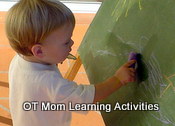 Toddler scribbling horizontal lines
Toddler scribbling horizontal linesTracing and then drawing spirals is a good way to practice the circular movement needed for circles!
First draw lots of bigger spirals on non-paper mediums and have your child trace them with a finger before trying them on paper.
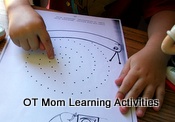
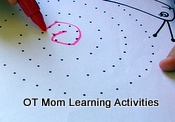
Squares and rectangles are harder because they require that your child STOP at corners and turn the corners.
Your child also needs to perceive how many sides there are and give their drawing the same number of sides.
However, the lines needed for squares and rectangles are horizontal and vertical, so they are still easier than triangles, which have diagonal lines.
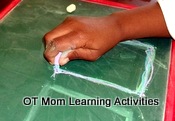 Learning To Draw A Square
Learning To Draw A SquareDiagonal Lines
Triangles are tricky because they are made up of at least one or two diagonal lines.
If your child struggles to draw triangles, then start by practicing lots of diagonal lines, before connecting them to make a triangle.
I always find it immensely helpful to stand behind the child and guide their hands through the tracing.
I talk them through it, emphasizing stopping at the corners and turning the corners.
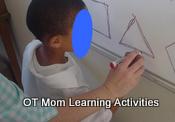 Hand-Over-Hand Guidance
Hand-Over-Hand GuidanceTry some visual motor integration activities with stars drawn with + and x .
Here, the child is tracing over the simple printed stars I made. She is working on a vertical surface.
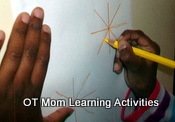
Or draw lots of slants ////\\\\ to make a fir tree and have your child go over and over the diagonal lines.
Once your child has practiced tracing over your diagonal lines, draw a fir tree like the one alongside and have your child try and copy it.
You will soon see whether the diagonals are weak or not.
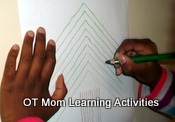
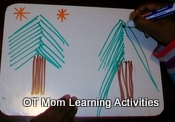
If your child has been practicing scissor cutting, a nice idea is to cut out triangles, paste them to make a picture (eg a house or a rocket) and then trace around them as shown.
You will need to cue the child to stop at each corner and make nice sharp turns.
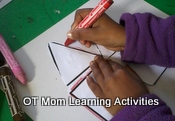 Tracing Around A Cut-Out
Tracing Around A Cut-OutTracing around a 5 point star can also help your child draw diagonals.
I drew a star on this Magnadoodle, and the child is tracing over it with a thicker magnet pencil.
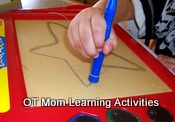 Tracing On A Magnadoodle
Tracing On A MagnadoodleDiagonal Lines With Lazy 8's
"Lazy 8's" make great visual motor integration activities to work on diagonals!
Work on a large vertical surface and turn your lazy 8 into a butterfly or a racing track to capture your child’s interest.
Your child should start at the top of the right hand loop (for a right handed child; see the car on the top of the racing track pic) and draw down the diagonal to the bottom of the left loop, up the left loop and down the diagonal to bottom of the right loop and back up again.
A left handed child should start at the top of the left loop and start down the diagonal from there.
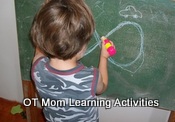 A Lazy 8 Racing Track
A Lazy 8 Racing TrackIf you look carefully, the tracing in the butterfly is not that great, as the child struggled to stay on the path, and the down strokes from left to right are more vertical than diagonal.
If you notice your child doing this, keep practicing this activity a few more times, encouraging the diagonal slant.
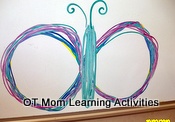 A Lazy 8 Butterfly
A Lazy 8 ButterflyYou can also draw a racing track, and have the child steer a car around the track, being careful to "drive on the road".
Patterns
Practicing handwriting patterns is a good way to develop the flow and ease needed for handwriting.
The patterns shown alongside were done by a child who had poor VMI skills. If you look closely, they are jerky, with lots of stopping and starting, and they lack flow.
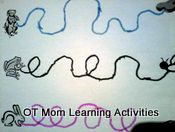 Poor VMI - patterns lack flow
Poor VMI - patterns lack flowIf you notice that your child struggles to make good, flowing patterns, then spend some time doing lots of patterns and looping paths on a large upright surface (white board, blackboard, outside wall, mirror).
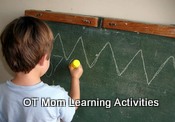
Once your child has had lots of practice with patterns on a big surface, you could print pattern downloads and have your child trace them a few times with a finger before trying them with a crayon. I use these printable visual motor worksheets a LOT to help develop these skills.
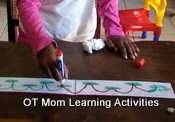
Some children also enjoy working on wipe-clean books like this Tracing and Pen Control Workbook#Ad.
My preference is to use thick wipe-clean markers to help with pencil control.
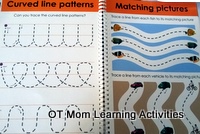
Your child may also benefit from doing some eye-hand coordination activities to strengthen eye-hand coordination skills.
Numbers And Letters
If your child struggles to write numbers and letters, first go back and check that they can draw shapes, diagonal lines and intersecting lines (+ and x) properly.
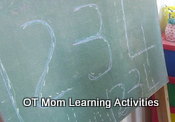 Number Formations
Number FormationsNumbers and letters all have specific starting points. Use a visual clue, like a dot or a small star to remind kids where to start.
 Letter Formations
Letter FormationsNumbers 1-7 all start in the top left corner, so you can call that the starting corner and then work on 2 or 3 numbers at a time with little rhymes or stories until your child has learned to write them.
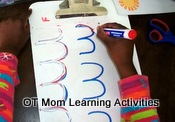
It is best to work on large surfaces before moving onto books and worksheets. Another tip is to have your child draw the letter in the air with closed eyes!
For more letter formation tips and strategies, visit these pages of my site:
Dots And Grids
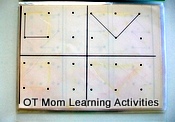
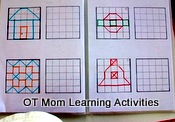
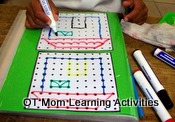
Dot pictures and grid pictures are helpful visual motor integration activities. They require the child to look carefully at the picture and replicate it, which is the same skill needed in handwriting!
Start with the really simple ones for young kids and progress to the harder ones as their skills develop.
At first, you will need to help your child by pointing out where the line starts and then going dot by dot or grid by grid.
Your child will need to have a good grasp of directionality in order to understand the concept of drawing "up one grid", "3 dots to the left" and so on.
The following printable downloads contain a whole range of worksheets that are graded from very easy to very difficult, so children of different ages and skills can benefit from the same e-book!
Visual Motor Integration Activities for Older Kids
Visual motor integration activities for older children invariably use pencil and paper. However, you can still manage to make it interesting for them!
Older kids can still benefit from some "large surface work" as shown by this boy tracing a whale outline on a blackboard.
Older children are usually better at understanding the instruction to "look carefully and to draw what you see", but it does take a lot of practice to help them refine that skill.
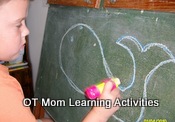
They often need reminders to "slow down" and "draw it in exactly the same way", and cues to stop at the dot or line, and to angle their lines in exactly the same way.
- Advanced grid drawings and dot pictures (such as those recommended above) are useful.
- Working with craft stencils also helps the child to get the visual and motor systems to work together.
Worksheets that teach kids to draw step-by-step, like the one alongside, are also good visual motor integration activities.
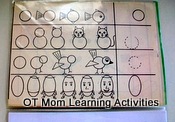
There are a range of "How to Draw" books#Ad that are geared to kids. These books can help them to learn to draw by copying a picture step-by-step.
VMI Activity Resources
Visual Motor Printables
I have made extensive use of these lovely printables to create visual motor integration activities for my own kids and for the kids I work with in local schools.
Just click on the images below to see the various downloads in more detail.
Thank you for visiting my site!I hope you found these visual motor integration activities to be helpful!
Why not sign up for my free, occasional newsletter to stay in touch with new activities and updated pages on my site?
- Home Page
- Visual Motor Integration
- Visual Motor Integration Activities
Share this page to help others!
Related Pages
These visual motor integration activities are useful for developing the foundation skills for handwriting. But working on motor skills and other visual perceptual skills is also important.
Check out these other pages on my site to help support your child in these areas.
Didn't find what you were looking for? Try a search of my site!
